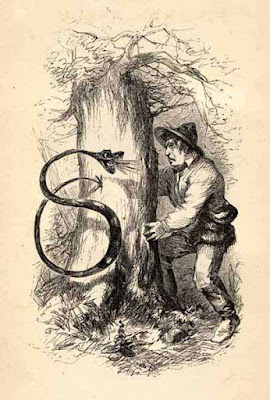 |
The Hoop Snake, image from Monstropedia |
Here are some new monsters designed for use with single characters (one-on-one play), small parties (perhaps without clerics), or younger players. Many contain a whimsical or fairy tale element for upping the fantastical during the game. Each monster has but a single hit point, meaning that any successful hit takes one out, so there is no need to track hit points, just the number of monsters. Each monster also attacks as a normal human using the Holmes Basic rules (THAC0 20), and does but a single point of damage on a successful hit.
All of the monsters have the same stats unless otherwise indicated on the table below:
HD 1/8 (1 hit point, attacks as Normal Human with THAC0 20), 1 attack that does 1 point of damage (DMG 1 x 1), AC 7, Combat Move of 20' per round of 10 sec, and an average Dex of 10. Each monster is worth 1 XP, or 2 if it has a special attack/defense. The number appearing is 1d8 times the dungeon level or wilderness zone difficulty level. Treasure is present 50% of the time, and is equal to 1d20 times the total XP value of the monsters, and can be in the form of coins, gems, jewelry or other valuables.
For larger parties or higher level characters, 10 times the number of 1HP monsters can be used, perhaps with an optional Swarm rule: roll for damage normally, but the result equals the number of 1 hp monsters destroyed in a single attack. If desired, each of these monsters can also be easily increased to 1/4, 1/2 or 1 HD, and do 1-6 hp of damage per attack.
Update: Apparently the table, cut and pasted from Word, was not showing up on some computers, and was messing up the formatting of this blog. I've reformatted the table as a 1-page pdf that can be downloaded via the Holmes Reference Sheets page on the ZA site. I've put a screenshot of this pdf below.
Notes:
A "friendly talking magpie" is mentioned by Gygax in the module B2. Vampire Bats are mentioned by Holmes as having AC3 in the combat section of the Basic rulebook but not otherwise described. The particular version of the Jack-in-the-Green is inspired by the fantasy novel Mythago Wood by the late Robert Holdstock. The other monsters are inspired by folklore, natural history or wordplay.






